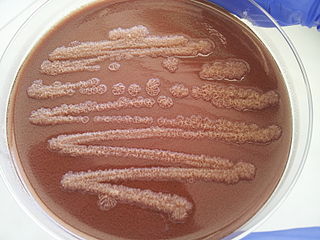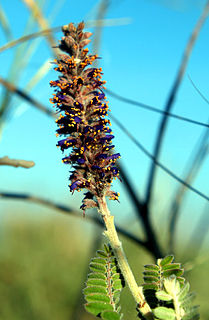Related Research Articles

Sinorhizobium meliloti are an aerobic, Gram-negative, and diazotrophic species of bacteria. S. meliloti are motile and possess a cluster of peritrichous flagella. S. meliloti fix atmospheric nitrogen into ammonia for their legume symbionts, such as alfalfa. S. meliloti forms a symbiotic relationship with legumes from the genera Medicago, Melilotus and Trigonella, including the model legume Medicago truncatula. This symbiosis promotes the development of a plant organ, termed a root nodule. Because soil often contains a limited amount of nitrogen for plant use, the symbiotic relationship between S. meliloti and their legume hosts has agricultural applications. These techniques reduce the need for inorganic nitrogenous fertilizers.

The Hyphomicrobiales are an order of Gram-negative Alphaproteobacteria.

Pseudomonas stutzeri is a Gram-negative soil bacterium that is motile, has a single polar flagellum, and is classified as bacillus, or rod-shaped. While this bacterium was first isolated from human spinal fluid, it has since been found in many different environments due to its various characteristics and metabolic capabilities. P. stutzeri is an opportunistic pathogen in clinical settings, although infections are rare. Based on 16S rRNA analysis, this bacterium has been placed in the P. stutzeri group, to which it lends its name.

Sinorhizobium/Ensifer is a genus of nitrogen-fixing bacteria (rhizobia), three of which have been sequenced.

Streptomyces griseus is a species of bacteria in the genus Streptomyces commonly found in soil. A few strains have been also reported from deep-sea sediments. It is a Gram-positive bacterium with high GC content. Along with most other streptomycetes, S. griseus strains are well known producers of antibiotics and other such commercially significant secondary metabolites. These strains are known to be producers of 32 different structural types of bioactive compounds. Streptomycin, the first antibiotic ever reported from a bacterium, comes from strains of S. griseus. Recently, the whole genome sequence of one of its strains had been completed.

Amorpha canescens, known as leadplant, downy indigo bush, prairie shoestring, or buffalo bellows, is a small, perennial semi-shrub in the pea family (Fabaceae), native to North America. It has very small purple flowers with yellow stamens which are grouped in racemes. Depending on location, the flowers bloom from late June through mid-September. The compound leaves of this plant appear leaden due to their dense hairiness. The roots can grow up to 5 m (16 ft) deep and can spread up to 1 metre radially. This plant can be found growing in well-drained soils of prairies, bluffs, and open woodlands.

Mesorhizobium is a genus of Gram-negative soil bacteria. At least one, the nitrogen fixing species, Mesorhizobium loti, forms symbiotic root nodules with plants in the genus Lotus. Strain MAFF303099 of M. japonicum has been fully sequenced.
Pseudomonas protegens are widespread Gram-negative, plant-protecting bacteria. Some of the strains of this novel bacterial species previously belonged to P. fluorescens. They were reclassified since they seem to cluster separately from other fluorescent Pseudomonas species. P. protegens is phylogenetically related to the Pseudomonas species complexes P. fluorescens, P. chlororaphis, and P. syringae. The bacterial species characteristically produces the antimicrobial compounds pyoluteorin and 2,4-diacetylphloroglucinol (DAPG) which are active against various plant pathogens.
Mesorhizobium loti, formerly known as Rhizobium loti, is a Gram negative species of bacteria found in the root nodules of many plant species. Its name is a reference to Lotus corniculatus, a flowering plant from which it was originally isolated.
Sinorhizobium fredii is a nitrogen fixing bacteria of the genus Sinorhizobium. It is a fast-growing root nodule bacteria. Sinorhizobium fredii exhibit a broad host-range and are able to nodulate both determinant hosts such as soy as well as indeterminate hosts including the pigeon pea. Because of their ease of host infection there is interest in their genetics and the symbiotic role in host infection and nodule formation.
Mesorhizobium tianshanense, formerly known as Rhizobium tianshanense, is a Gram negative species of bacteria found in the root nodules of many plant species. Its type strain is A-1BS.
Mesorhizobium plurifarium is a species of root nodule bacteria first isolated from Acacia species in Senegal. Its type strain is ORS 1032.
Mesorhizobium albiziae is a bacterium from the genus of Mesorhizobium which was isolated from a subtropical region in China.
Mesorhizobium caraganae is a gram-negative, aerobic, non-spore-forming, motile bacteria from the genus of Mesorhizobium which was isolated from root nodules of Caragana microphyllain in the Beipiao City in the Liaoning Province in China.
Mesorhizobium chacoense is a gram-negative, aerobic, non-spore-forming, motile bacteria from the genus of Mesorhizobium which was isolated from root nodules of Prosopis alba in the Chaco Arido region in Argentina.
Mesorhizobium ciceri is a gram-negative, nitrogen-fixing motile bacteria from the genus of Mesorhizobium which was isolated from Chickpea nodules of Cicer arietinum in Spain. Rhizobium cicero was transferred to Mesorhizobium ciceri.
Mesorhizobium mediterraneum is a bacterium from the genus Mesorhizobium, which was isolated from root nodule of the Chickpea in Spain. The species Rhizobium mediterraneum was subsequently transferred to Mesorhizobium mediterraneum. This species, along with many other closely related taxa, have been found to promote production of chickpea and other crops worldwide by forming symbiotic relationships.
Mesorhizobium muleiense is a bacterium from the genus Mesorhizobium which was isolated from Cicer arietinum in Xinjiang in China.
Sinorhizobium americanum is a bacterium first isolated from root nodules of Acacia species native of Mexico. Its type strain is CFNEI 156.
Klebsiella variicola is a species of bacteria which was originally identified as a benign endosymbiont in plants, but has since been associated with disease in humans and cattle as well.
References
- ↑ Wang ET, Rogel MA, Sui XH, Chen WX, Martínez-Romero E, van Berkum P (October 2002). "Mesorhizobium amorphae, a rhizobial species that nodulates Amorpha fruticosa, is native to American soils". Archives of Microbiology . 178 (4): 301–5. doi:10.1007/s00203-002-0448-9. PMID 12209264. S2CID 15741698.
- ↑ Hao, X.; Lin, Y.; Johnstone, L.; Baltrus, D. A.; Miller, S. J.; Wei, G.; Rensing, C. (2012). "Draft Genome Sequence of Plant Growth-Promoting Rhizobium Mesorhizobium amorphae, Isolated from Zinc-Lead Mine Tailings". Journal of Bacteriology. 194 (3): 736–737. doi:10.1128/JB.06475-11. ISSN 0021-9193. PMC 3264094 . PMID 22247533.